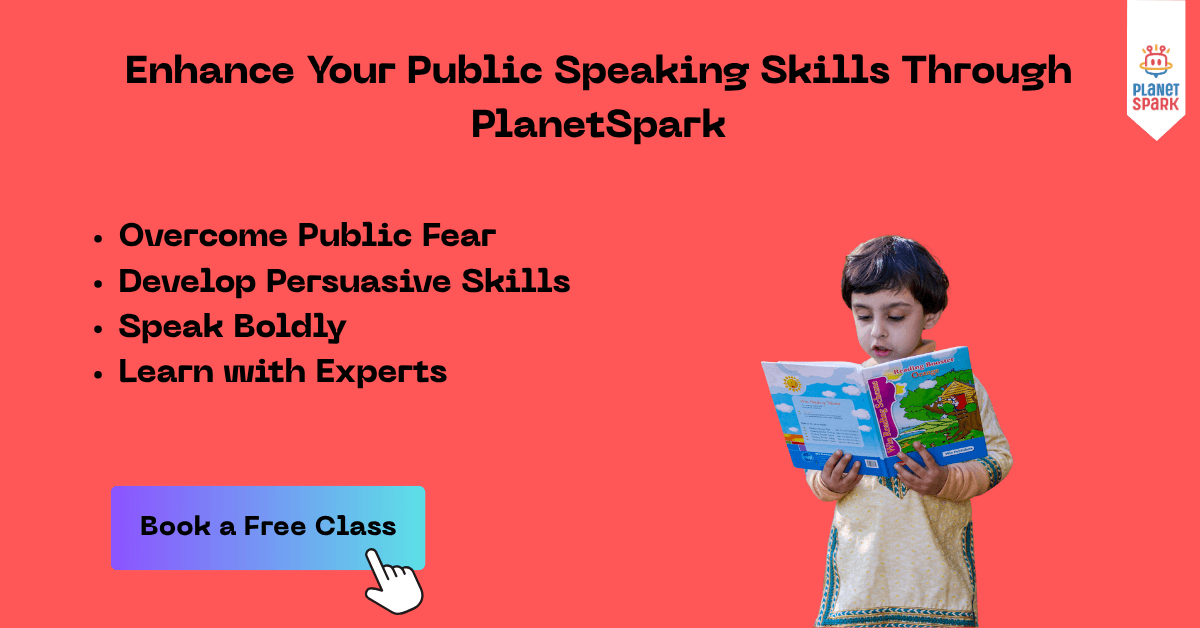Spark Creativity with Top 15 Story Reading Books for Kids 3–8

What if reading stories could make your child confident, expressive, and imaginative? Every child loves a story but stories can do more than entertain! They spark creativity, build vocabulary, and even boost communication skills. From giggles over silly rhymes to thrilling adventures with brave heroes, the right books help children grow emotionally, socially, and creatively.
In this blog, we’ve curated the top 15 story reading books for kids aged 3–8 years, including Pre-schooler favourites (3–5 years) and early Elementary picks (6–8 years). Each story comes with a description and tips on how it nurtures reading, expression, and confidence.
At PlanetSpark, we believe reading and storytelling go hand-in-hand with communication skills, helping children enjoy stories while learning to express themselves boldly.
Best Story Books for Preschoolers (Ages 3–5)
1. The Very Hungry Caterpillar by Eric Carle: A Journey of Growth and Discovery
This timeless picture book follows a tiny caterpillar who munches his way through apples, pears, strawberries, and more before transforming into a beautiful butterfly. With its bright illustrations, simple text, and die-cut pages, it captures every preschooler’s attention. Each turn of the page introduces new foods and numbers, helping children learn counting, sequencing, and the days of the week in a fun, visual way.
Beneath its charming simplicity lies a story of growth and transformation. The caterpillar’s journey mirrors a child’s own development full of curiosity, small mistakes, and wonderful discoveries. The repetition encourages early reading confidence, while the colourful visuals stimulate observation skills and vocabulary.
This book isn’t just a story it’s an early learning adventure that teaches patience, change, and self-discovery. Parents and teachers can use it for interactive reading, helping children point to foods, count fruits, or talk about healthy eating habits.
How It Teaches Growth and Patience
Shows that every stage of growth is important.
Encourages curiosity and appreciation for nature.
Helps children understand that progress takes time just like the caterpillar’s transformation.
Transform storytime into skill-building adventures
2. Goodnight Moon by Margaret Wise Brown: The Comfort of Routine
In this soothing bedtime classic, a little bunny says goodnight to everything in his softly lit green room from the moon and the stars to the kittens and mittens. The simple rhyming text and gentle illustrations create a sense of calm and security, making it a bedtime favourite for generations.
For young children, the familiar repetition provides comfort and predictability key elements for emotional stability. The book also encourages mindfulness by drawing attention to small details often overlooked in daily life. Parents can use it as part of their bedtime ritual to build consistency and peace before sleep.
Beyond its lullaby-like rhythm, Goodnight Moon nurtures early observation, vocabulary, and emotional connection. It teaches children the beauty of winding down, gratitude, and appreciating their surroundings.
How It Builds Calmness and Mindful Habits
Encourages peaceful routines before sleep.
Teaches mindfulness through gentle observation.
Helps anxious or restless children find comfort in familiar patterns.
3. Giraffes Can’t Dance by Giles Andreae: Embracing Uniqueness
Gerald the giraffe feels awkward and out of place at the Jungle Dance because his long legs and neck make it hard to move like the others. But when he listens to his own rhythm, he discovers that everyone can dance they just need the right tune!
This joyful story combines poetic rhythm with a powerful message of self-belief. It teaches kids that everyone has their own strengths, even if they don’t fit into the crowd. The colourful jungle scenes capture attention, while the musical tone enhances reading fluency and emotional expression.
As children read or perform this story aloud, they naturally develop body awareness, confidence, and self-expression essential skills for creative growth.
Why It Inspires Confidence and Self-Love
Helps children embrace their individuality without fear of judgement.
Teaches that everyone shines differently and that’s okay.
Encourages kids to find joy in their own talents, not comparisons.
4. Room on the Broom by Julia Donaldson: Teamwork and Friendship
A friendly witch and her cat embark on a flying adventure but as the wind blows away her belongings, several animals help her retrieve them. In return, she makes “room on the broom” for everyone. When a dragon attacks, it’s her new friends who save the day!
This heartwarming story blends rhyming text, humour, and teamwork into one delightful reading experience. Children love the repetition and sound patterns, while the moral highlights kindness and inclusion. The vibrant illustrations invite participation kids can predict rhymes, repeat phrases, and act out scenes, which enhances memory and speaking skills.
It’s also a great story for classroom roleplay, helping kids understand cooperation and empathy through fun character voices.

How It Encourages Kindness and Team Spirit
Teaches the value of helping and including others.
Shows that teamwork can overcome even the scariest problems.
Inspires gratitude and the importance of friendship in tough times.
5. Where’s Spot? by Eric Hill: Fun with Curiosity and Discovery
Where’s Spot? is a playful lift-the-flap book that follows a mother dog as she searches for her mischievous puppy, Spot. Each page hides surprises under colourful flaps, keeping young children engaged and excited as they lift each one to reveal what’s underneath. The simple story structure makes it easy for preschoolers to follow along while introducing basic concepts like prepositions (“under,” “behind,” “inside”), spatial awareness, and cause-and-effect thinking.
The story encourages curiosity, observation skills, and problem-solving in an interactive and entertaining way. By inviting children to guess where Spot might be, it helps develop prediction skills and early logic. The repetitive phrasing also builds early reading confidence, making it a favourite for shared parent-child reading sessions.
Beyond just learning, Where’s Spot? fosters patience and attentive listening. Children eagerly participate in the story, pointing to flaps, guessing outcomes, and discussing Spot’s adventures making reading a hands-on experience rather than a passive activity.
How It Builds Observation and Problem-Solving Skills
Encourages children to predict outcomes and explore possibilities.
Develops spatial awareness and vocabulary through interactive flaps.
Cultivates curiosity, attention to detail, and joyful participation in reading.
6. Chicka Chicka Boom Boom by Bill Martin Jr.: Learning Letters with Rhythm
Chicka Chicka Boom Boom is a vibrant, rhythmic alphabet adventure where letters climb a tall coconut tree until they tumble down with a cheerful “boom boom!” Children are captivated by the playful rhymes, bold colours, and dynamic typography. The story’s rhythm encourages oral reading fluency and makes it memorable for young learners.
This book helps children associate letters with sounds and sequences, improving alphabet recognition and phonemic awareness. Its repetitive, musical text enhances memory and makes it easier for preschoolers to recall letters in order. The playful narrative also stimulates engagement, encouraging children to chant along and participate actively.
Teachers and parents can use this story for sing-along activities, alphabet games, or even acting out the letters’ climb and tumble, which adds movement-based learning. The combination of humour, rhythm, and visuals ensures that learning the alphabet is fun, interactive, and highly memorable.
Why It Makes Learning Letters Exciting
Builds letter recognition and phonics awareness through rhythm and repetition.
Encourages participation in reading and memory-based activities.
Shows that learning can be fun and interactive, not just rote memorisation.
Unleash your child’s confidence and let their voice be heard!
Take a free demo class today and watch them transform into a bold, expressive speaker.
7. Brown Bear, Brown Bear, What Do You See? by Eric Carle: Observing and Understanding the World
This classic picture book introduces a series of colourful animals, each seen by the next in turn. With its simple, repetitive phrasing, young children quickly learn to anticipate what comes next, improving prediction, memory, and vocabulary skills. The bold illustrations by Eric Carle make each animal memorable, keeping children visually engaged while enhancing observational abilities.
The story also introduces colours, animals, and sequencing in an intuitive way. Children enjoy pointing at the animals, naming them, and mimicking sounds, which strengthens speech, pronunciation, and listening skills. The rhythmic text naturally encourages read-aloud sessions, where expressive intonation and repetition boost confidence in early readers.
Beyond learning colours and animals, Brown Bear, Brown Bear fosters mindfulness and attention to detail. Children learn to focus, follow patterns, and notice differences, which are foundational skills for both literacy and critical thinking.
How It Teaches Observation and Pattern Recognition
Encourages focus and attentive listening.
Reinforces vocabulary, colours, and sequencing skills.
Promotes memory, prediction, and early storytelling confidence.
Best Story Books for Early Elementary Kids (Ages 6–8)
8. Charlotte’s Web by E. B. White: Friendship and Compassion in Action
This beloved classic tells the heartwarming story of Wilbur, a gentle pig, and his wise spider friend, Charlotte. When Wilbur faces the threat of the farmer’s butcher, Charlotte spins words in her web to save him. The story weaves together themes of loyalty, empathy, and the beauty of selfless friendship.
Beyond the compelling narrative, Charlotte’s Web encourages children to understand emotions both their own and others’. The detailed descriptions, longer chapters, and relatable animal characters help early elementary readers enhance vocabulary, comprehension, and sustained attention. Parents and teachers can use the book to spark discussions about kindness, caring for animals, and the value of friendship.
Through reading aloud or performing scenes, children develop emotional intelligence and empathy. They learn how acts of kindness can have meaningful impacts, while connecting with the feelings of the characters.
How It Teaches Empathy and Emotional Awareness
Shows the power of friendship and selfless acts.
Encourages children to notice and respond to others’ emotions.
Helps kids understand loyalty, compassion, and the value of words.
9. The Magic Tree House Series by Mary Pope Osborne: Adventures Through Time and Learning
Jack and Annie discover a magical treehouse that whisks them on thrilling adventures through history from ancient Egypt to dinosaur-filled landscapes. Each book combines action, problem-solving, and educational content, making reading both fun and informative.
This series develops curiosity and knowledge across subjects like history, science, and geography. The short chapters, clear plots, and relatable sibling characters help children transition from picture books to longer stories. Repetitive phrases and engaging cliffhangers keep kids motivated to read more.
Reading these books encourages imagination, analytical thinking, and observation skills. When children predict what will happen next or discuss Jack and Annie’s problem-solving strategies, they enhance reasoning and comprehension.
How It Boosts Curiosity and Critical Thinking
Introduces historical and scientific concepts in a fun way.
Encourages children to ask questions and explore beyond the story.
Promotes problem-solving by seeing how Jack and Annie overcome challenges.
Watch your child shine on stage
10. Dog Man by Dav Pilkey: Humor, Justice, and Relatable Lessons
A half-dog, half-man police officer fights crime with comic adventures that captivate young readers. The comic-style panels make reading approachable for reluctant readers while teaching values like honesty, teamwork, and responsibility.
The series encourages humour, creativity, and emotional intelligence. Kids identify with the characters’ challenges, mistakes, and triumphs, learning resilience and problem-solving. Repetitive story elements help build reading fluency, while expressive illustrations support comprehension.
How It Teaches Resilience and Problem-Solving
Shows that mistakes can lead to growth and learning.
Encourages teamwork and fair play.
Promotes enjoyment in reading and understanding consequences.
11. The Tale of Peter Rabbit by Beatrix Potter: Responsibility and Consequences
Peter Rabbit’s mischievous adventure in Mr. McGregor’s garden teaches children about curiosity, consequences, and careful choices. Potter’s charming illustrations and engaging narrative immerse kids in a whimsical world that’s easy to visualise and follow.
The story encourages decision-making skills and responsibility while nurturing empathy for animals. Children can predict outcomes and discuss alternative actions, which enhances reasoning and moral understanding.
How It Teaches Responsibility and Curiosity
Shows that choices have consequences.
Encourages children to think about right and wrong.
Inspires curiosity while balancing caution and safety.
12. The Princess in Black by Shannon Hale and Dean Hale: Courage Beyond Appearances
By day, Princess Magnolia is a typical royal, but by night she fights monsters as the Princess in Black. This early chapter book encourages kids, especially girls, to embrace bravery and adventure while challenging stereotypes about appearances and abilities.
The book fosters confidence, imagination, and problem-solving skills. Children learn that courage can come in surprising forms, and that teamwork, strategy, and thinking creatively can solve problems. The narrative style also encourages fluency, expressive reading, and comprehension.
How It Inspires Courage and Self-Confidence
Teaches children that appearances don’t limit ability.
Encourages bravery, leadership, and strategic thinking.
Shows that teamwork can help overcome difficult challenges.
13. Dragons Love Tacos by Adam Rubin: Humor and Imaginative Thinking
This silly, humorous story explains that dragons adore tacos but cannot handle spicy salsa! Children delight in the absurdity, while engaging with patterns, cause-and-effect, and imaginative problem-solving.
The story encourages humour, creative thinking, and emotional engagement. Kids learn to predict outcomes, explore “what if” scenarios, and enjoy playful language. It’s perfect for read-aloud sessions, encouraging expressive voices, laughter, and fun roleplay.

How It Teaches Humour and Creativity
Encourages imaginative problem-solving.
Shows that paying attention to details avoids unexpected trouble.
Promotes laughter, engagement, and joy in storytelling.
14. The Pigeon Finds a Hot Dog! by Mo Willems: Decision-Making and Expression
Pigeon hilariously debates whether to share a hot dog, using exaggerated facial expressions and simple dialogue. Children love interacting with the story, predicting outcomes, and expressing opinions aloud.
The book teaches negotiation, empathy, and expressing feelings appropriately. Its repetitive, humorous dialogue supports early reading confidence and oral storytelling skills. Acting out Pigeon’s emotions also helps children connect feelings with voice, tone, and body language.
How It Builds Expression and Social Skills
Teaches negotiation, patience, and sharing.
Encourages expressive reading and storytelling.
Helps children understand emotions and perspective-taking.
15. Magic School Bus: Inside the Human Body by Joanna Cole: Learning Through Adventure
Ms. Frizzle’s class embarks on a wild journey inside the human body, exploring organs, blood flow, and systems. This nonfiction-adventure hybrid makes science engaging, visual, and interactive.
Children develop curiosity, observation skills, and scientific understanding while enjoying storytelling. The combination of factual content and narrative context reinforces learning in a memorable, fun way. Discussions about the story promote reasoning and comprehension.
How It Sparks Curiosity and Scientific Thinking
Introduces complex science in an engaging way.
Encourages observation, questioning, and exploration.
Promotes enthusiasm for learning and connecting knowledge to real life.
Why PlanetSpark is Every Child’s Storytelling Superpower
At PlanetSpark, we believe that every story has the power to unlock a child’s confidence. Storytelling isn’t just reading aloud—it’s expressing ideas, emotions, and imagination with clarity and poise. Our programs turn shy or hesitant readers into confident communicators, blending fun with structured learning.
Why Parents Trust PlanetSpark:
1:1 Expert Coaching: Personalized guidance from certified communication and child psychology trainers.
Step-by-Step Skill Building: Covers body language, voice modulation, storytelling, debating, and persuasive speech.
TED-Style Framework: Kids learn the “Hook–Message–Story–CTA” framework, building presentation skills like TEDx speakers.
Global Practice Platforms: Live discussions, debates, and storytelling circles with peers from 13+ countries.
Competitions & Leagues: National-level Public Speaking League and regular contests boost real-world confidence.
Video Feedback Loop: Children review their recorded speeches with coaches for continuous improvement.
By combining story reading with expressive practice, PlanetSpark transforms bedtime tales into confidence-building adventures, where children not only read but perform, narrate, and present stories confidently.
From Storybooks to Stage Confidence: Make Every Tale Count!
Storybooks are more than bedtime fun they’re stepping stones to creativity, expression, and confidence. When children read, perform, and narrate stories, they learn to speak clearly, express emotions, and think imaginatively.
At PlanetSpark, we help children turn these stories into real-life confidence. Through guided storytelling, expressive reading, and fun public speaking exercises, your child can transform from a shy reader into a confident communicator on stage and in everyday life.
Encourage your child to read, act, and speak and watch every story unlock their true potential!
Frequently Asked Questions
Daily reading improves vocabulary, imagination, comprehension, and emotional intelligence. It also helps children develop confidence in expressing ideas and boosts early communication and social skills.
Yes! Many storybooks, like Magic Tree House or The BFG, combine entertaining stories with lessons on history, science, problem-solving, and moral values.
Ask your child to retell the story in their own words, act out characters, or use different voices. These activities enhance comprehension, memory, and self-expression.
PlanetSpark’s programs combine storytelling with structured public speaking training. Kids learn voice modulation, body language, and presentation skills while performing stories, turning reading into a confidence-building experience.
Children learn articulation, voice modulation, body language, empathy, creativity, and stage presence—all vital for school presentations, debates, and everyday communication.
Look for books that match your child’s interests and reading level. Preschoolers enjoy picture books with rhymes and simple plots, while early elementary kids prefer chapter books, graphic novels, and adventure or nonfiction stories.
Absolutely! Reading aloud, repeating rhymes, and narrating stories improve vocabulary, sentence structure, listening skills, and confidence in expressing ideas clearly.
Personalized Communication Report
Record a video to get a AI generated personalized communication report for your child

Hi There, want to try these
tips for your child with
LIVE with our expert coach?
Let's check your child's
English fluency
